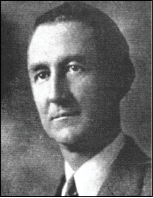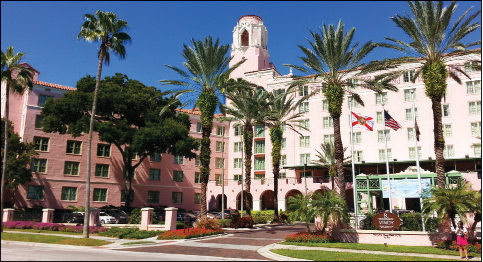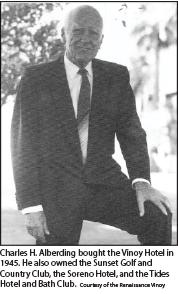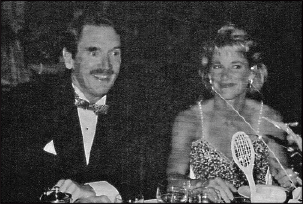By Will Michaels, executive director and trustee of the St. Petersburg
Museum of History
and author of "The Making of St. Petersburg"
Northeast Journal.org, Village Green Publishing.
published November 26, 2014
This Website is used solely for my personal,
non-commercial use!
The historic "Vinoy Park Hotel" was built by Aymer
Vinoy Laughner in 1925. The architect was Henry Taylor, who also
designed St. Mary’s Church, Comfort Station No. 1, the Jungle
Hotel (now Admiral Farragut), the Jungle Prada, and the Florida
Theater. The cost of construction was $3.5 million – at
the time, the largest construction project in Florida history.
The Vinoy was the largest and most luxurious of St. Petersburg’s
boom-era hotels.
 
– Courtesy of the Vinoy Renaissance Resort
Aymer Vinoy Laughner (1883-1961) built the "Vinoy Park
Hotel". Laughner was from Pennsylvania where he made his
fortune in the oil business. He served on the St. Petersburg
City Commission from 1930 to 1934.
According to historic hotel author Prudy Taylor Board, the Vinoy
was sparked as the result of a wager made between Laughner and
1920’s golf champion Walter Hagen. At a party at Laughner’s
house on Beach Drive near the present site of the Vinoy, Laughner
bet Hagen that he could not hit golf balls off the top of Laughner’s
watch without breaking the crystal. Hagen won the wager. When
Laughner and another guest went to retrieve the golf balls from
the neighbor’s lawn, the guest commented on what a nice
site the waterfront home would be for a hotel. The rest is hotel
history.

The Vinoy Renaissance St. Petersburg Resort & Golf Club
will celebrate its 90th birthday in 2015
 Play amazing YouTube
video of an aerial view of the Vinoy and surrounding property! Play amazing YouTube
video of an aerial view of the Vinoy and surrounding property!
The Vinoy came to be famous for its gourmet cuisine and
famous guests. Sometimes these did not always go together. An
early visitor was President Calvin Coolidge known for his simple
tastes. According to hotel lore, he preferred to eat in the employees’
cafeteria rather than in the hotel’s fine restaurant. Other
hotel guests of note included President Herbert Hoover, explorer
Admiral Richard Byrd, novelist Ernest Hemingway, essayist H.L.
Mencken and actor Jimmy Stewart, to name a few. It had not been
documented if baseball legend Babe Ruth actually stayed at the
hotel, but he spent a lot of time there and was a good friend
of the Laughner family. The film "The Break" with Vince
Van Patten was filmed at the Vinoy in 1995.
The Vinoy continued as a luxury seasonal hotel until World War
II (it typically operated from October to early April –
there was no air conditioning). During the war years guests stopped
coming and the hotel was converted into housing for the "Army
Air Corps" and later as an R&R facility for the "U.S.
Maritime Commission".

Charles H. Alberding bought the Vinoy Hotel in 1945. He also
owned the Sunset Golf and Country Club, The Soreno Hotel, and
the Tides Hotel and Bath Club.
– Courtesy of the Vinoy Renaissance
Resort
After the war, the hotel struggled. In 1945, Laughner sold
the Vinoy to "Alsonett Hotels", a hotel chain based
in Chicago owned by Charles Alberding. Alberding at first succeeded
in again making the hotel a success, but eventually found it
a losing proposition. In 1972, Bob Reynolds, only 20 years old
at the time, offered to buy the hotel from Alberding. Bob was
a St. Petersburg native who had fallen in love with the hotel
as a child and always harbored an ambition to own it. Surprisingly,
Alberding agreed to sell it even though Reynolds only had $10,000
cash. A lease was drawn up with a six month option to purchase
the hotel for $5 million. Reynolds organized as "R.W. Enterprises"
with four partners. He then enlisted architect and city mayor
C. Randolph (Randy) Wedding to draw up plans for the hotel’s
restoration. Wedding soon also became treasurer and a major advocate
for the project. But Reynolds and Wedding failed to obtain the
necessary financial backing. In 1974, for the first time in its
history, the hotel was closed. In late 1975, the hotel was reopened.
In an act of desperation, rates were slashed from $50 a night
to a mere $7. The once elegant ballroom was used for public dances,
card parties, and even volleyball. But even these radical changes
failed to keep the hotel afloat, and soon even the Vinoy’s
remaining fine furnishings were sold to help pay bills. The Vinoy
was again closed in 1975. It was not just the Vinoy that was
in bad shape in the 1980’s, but the entire downtown. The
commercial wind had been sucked out of the downtown with the
opening of Central Plaza on Highway 19, and the rise of suburban
shopping in the 1950’s, and the construction of Tyrone Mall
in 1972. The last major downtown retail store, Maas Brothers,
closed in 1991.
In 1978, the Vinoy was named to the "National Register of
Historic Places", making it possible for investors to obtain
federal tax breaks. Craig McLaughlin, who was later a principal
in the Vinoy’s restoration, recalls the project eventually
received federal tax credits amounting to 25% of the project’s
hard costs. In 1986, it was also designated a local landmark.
Still later it was added to the National Trust for Historic Preservation’s
"Historic Hotels of America".
The hotel languished for the next 18 years. Horror stories abounded.
One journalist wrote, “The hotel brings to mind Blanche
DuBois, the faded beauty from "A Streetcar Named Desire".
She always depended on the kindness of strangers, who often did
her wrong.” He went on, “This lady is a mess…
Pigeons fly into the grand ballroom as vines crawl through the
windows.” On one city-led tour in the late 1980’s,
potential developers walked in to find a nonpaying guest roasting
one of the pigeons on a stick over a small fire he had started
in the lobby. Standing water was a breeding ground for mosquitoes.
High school kids snuck in to drink beer and play kickball in
the ruins of the main dining room. At one point, the hotel was
fenced in and patrolled by guard dogs, but the dogs got loose
and ran about the waterfront.
Celebrated Times columnist, Jeff Klinkenberg, reported rumors
of “at least one hungry alligator [in the basement] with
an appetite for rodents and misplaced feet.”

Fred
Guest and tennis champion Chris Evert.
Guest is credited with saving the Vinoy. In addition to the hotel’s
successful $93 million restoration in 1992 the developers also
persuaded the Women’s Tennis Association to make the Vinoy
their headquarters.
– Courtesy of the Vinoy Renaissance
Resort
In 1980, Alberding refused to renew the lease with R.W. Reynolds,
and let new leases in succession with Gulfport developer Arthur
H. Padula and St. Petersburg businessman Robert V. Workman and
then J.J. Palumbo of Cincinnati. In 1983, Craig McLaughlin and
B.B. Anderson of the "B.B. Anderson Development Co."
of Kansas then bought the lease from Palumbo. McLaughlin was
also from Kansas, but was shortly to relocate to St. Petersburg.
McLaughlin and Anderson teamed up with Bert Stephens, a former
associate of Alberding and hotel operator, and Harold Geenen,
retired CEO of ITT. Stephens enlisted the participation of Fred
Guest, a well-respected retired stockbroker, investor, and investment
banker from New York. Guest had been interested in buying the
"Boca Raton Resort Hotel" which Stephens operated.
When that deal fell through, Stephens told Guest about the Vinoy.
Guest came to see the hotel, and as he later reported, “immediately
fell in love with it” despite its deplorable condition.
Fred Guest became the principal public advocate for the project.
They formed a partnership (except for Geenen who dropped out
of the project), and began what some derided as “Fred’s
Folly.” At the time, hotels were particularly difficult
properties to finance. The fact that it was also an historic
hotel, while offering potential tax and marketing advantages,
added to the difficulty because of the special approvals required
for construction.
The partnership determined that in order to make the Vinoy a
success they needed boat slips in the North Yacht Basin and city-owned
land adjacent to Seventh Avenue for tennis courts, including
most of Baywood Park. Baywood Park was a small park which included
a shallow Indian mound adjacent to the Vinoy. Baywood was commonly
considered at the time to be part of the waterfront parks receiving
special protection in the City Charter. This included the need
for a public referendum on any sale or long-term lease of waterfront
parkland. In its zeal to accommodate the Vinoy development, the
City Council contemplated an ordinance that would effectively
redefine Baywood as not a waterfront park and avoid a referendum.
Preservationists and others protective of the waterfront parks
led by former mayor Charles Schuh, attorney Peter Belmont, and
others immediately called foul and challenged the City’s
decision in court. After Circuit Judge Mark McGarry ruled that
Baywood was indeed a waterfront park, the Council backed down
and agreed to a compromise. A referendum would be held proposing
the exchange of most of Baywood Park, some other adjacent city
land, and the submerged land in front of the Vinoy, for a little
over six acres of land owned by the Vinoy that is now essentially
"Vinoy Park". The land to be ceded to the Vinoy was
restricted to recreational use. But, the referendum also included
stronger provisions in the City Charter clearly defining the
waterfront parks and other measures. As part of a related out-of-court
settlement, the City also agreed to enact a local preservation
ordinance which was done in 1986. The Vinoy was among the first
buildings to be designated local landmarks under the ordinance.
A referendum was scheduled on the swap for 1984. Shortly before
the required referendum was held, the Vinoy partners had an open
house. An amazing estimated 10,000 people turned out demonstrating
both curiosity and the deep emotional attachment many had for
the Vinoy. The referendum received overwhelming approval. In
1986, Guest, McLaughlin and Stephens organized as the "Vinoy
Development Corporation", with McLaughlin serving as president,
and worked out another lease with Alberding. In 1988, the corporation
enlisted the help of Smith Barney investment bankers to find
an equity player to invest in the hotel and manage it. An agreement
was secured with "Stouffer Hotels and Resorts".
The 1984 referendum included a provision that the boat slips
must be built within four years. Despite Guest and company’s
many efforts, they were not able to obtain sufficient financing
within that time period, and another referendum was held in 1989
to sustain the earlier decision. The St. Petersburg Times
supported the 1984 proposal, but opposed the matter the second
time arguing that the boat slips could be added later after the
developers obtained financing. The developers argued the reverse,
saying the marina approval was necessary to obtain the financing.
The boat slips were, in fact, something that Stouffer Hotels
insisted upon. The 1989 referendum was also approved, but this
time by a close vote. “The public was becoming tired of
the delays and trust that the restoration would be done was eroding,”
said McLaughlin. But the 1989 referendum cleared the way to securing
Stouffer’s investment. The deal was closed on February 22,
1990. Restoration construction now began in earnest.
The developers and architect were fervent in seeking to restore
the hotel to its original historic design. They sought to install
new wiring, plumbing, and air conditioning in a manner that minimally
infringed upon the original décor. The project was challenged
by the lack of blueprints. According to McLaughlin, they had
but a single sheet of historic plans to work from. When they
went to replace the roof, they found not one roof, but two, with
a water cistern in between. Local artist Tom Stovall and his
two-man crew worked eight hours a day for three months restoring
by hand the friezes, borders, and panels of just the dining room.
Much of the work was done lying on their backs. While it was
necessary to add some baffling over historic artwork in the dining
room, the architect was careful not to mar it. It remains hidden
to this day, perhaps to be rediscovered at some future time.
The staff architect for the state "Bureau of Historic Preservation"
closely followed the restoration. After it was completed, he
said, “I’ve seldom been involved with a project that
has spent this much time to restore the old materials, old designs,
and finishes.” In addition to the restoration of the original
hotel, a parking garage and 105-room tower were also constructed.
The developers further acquired the Sunset Golf Course on Snell
Isle to become a part of the hotel’s amenities, and famed
golf course architect Ron Garl was enlisted to renovate the course.
"The Women’s Tennis Association" was also convinced
to make the new Vinoy their headquarters.
|



